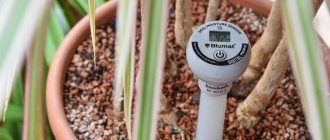Violet is a beautiful and very delicate flower with velvety leaves and beautiful blooms that will decorate the interior of any room.
In order for it to please with its appearance, it needs constant and proper care.
The most important part of care is timely watering . Our material today is dedicated to him.
Requirements for growing conditions
Saintpaulias or indoor violets are often grown, and gardeners wonder how to water violets correctly and what growing conditions are most suitable for plants. Among the features of growing indoor flowers, you need to consider the following:
- Small pots are used for plants. A spacious flower container stimulates the appearance of leaves, but there will be no buds;
- the soil should be light and well breathable. It is also necessary to pay great attention to drainage. In heavy soil, violets will begin to turn yellow and may die;
- air humidity is high. The air around the plants must be humidified using a spray bottle;
- in summer the plant needs a little shade. Direct sunlight can harm delicate leaves.
The plant also needs regular watering and fertilization. It is necessary to water the bush carefully so that drops do not fall on the leaves.
Important! Inexperienced gardeners often make mistakes and spray water on the plant. This can lead to the appearance of diseases on the surface of the leaf.
Watering indoor plants in the absence of owners: how to water house flowers during vacation
If you need to leave and there is no neighbor who could occasionally water the flowers, then you need to ensure that the plants are self-maintaining. This is possible, at least for some time.
Watering indoor plants in the absence of owners can be done using homemade water supply systems. The following methods have proven themselves well and do not require large expenses:
- Thick Strings: Arrange pots of flowers around a bucket or large pan of water. Take long lamp wicks or cotton threads and stick one end into the soil of the pots. The second end is lowered into the bucket. If the threads are pre-wetted, the flow of water will improve.
- A greenhouse made from a bag for plants that need high air humidity. A greenhouse from a bag will serve as an excellent option for moistening flowers during the holidays.
In specialized stores you can find a number of different systems for watering home flowers during the holidays. In any case, you should first check how long the water supply lasts.
A wet canvas is used to provide water to a large number of plants. The canvas can be placed on a surface next to the kitchen sink tank with one end of it in the water. Plants placed on a damp canvas can absorb moisture from it. The pots for this must be clay.
A clay cone for watering indoor flowers during the holidays can be recommended for single pots. It is filled with water and connected with a hose to the tank.
If you want to save yourself from such problems with watering as too much or too little, today or tomorrow, you can transplant all your plants into pots with automatic water supply. They are containers with a double bottom where a reservoir of water is located. Through a wick or similar device, the plant itself takes in exactly as much water as it needs. Naturally, such a device only works as long as you remember to replenish your water supply. This must be done every 14 days. But for the period of a short vacation, your plant is provided with water.
The last section of the article is devoted to how to wash indoor plants.
Proper watering
In order for buds to appear, you need to know how to water violets. The plant prefers warm water that has previously settled. Water must be carefully introduced into the soil under the leaves. After the water has completely saturated the soil, excess liquid from the pan must be removed. Often, excessive moisture leads to rotting of the roots. Therefore, in order to understand how often to water violets at home, it is recommended to take a closer look at the soil. If the top layer of soil is dry, moisture is added. If it is wet, no watering is carried out.
You can also water the plant through a tray. To do this, warm water is poured into the tray and a flower pot is placed. However, using this method, you also need to know how often to water your violets. Watering with this method is carried out no more than once a week. The duration of the procedure is 15-20 minutes, after which excess moisture is removed.
Why it's important to do it right
Violet is very picky about the quality of watering. She is a guest from southern Africa, and therefore does not tolerate waterlogging , especially if water gets into the center of the flower - the so-called growing point.
A white coating forms on the stem, after which it begins to rot. The lower leaves also disappear.
The root system becomes covered with a black coating and absorbs moisture from the ground worse.
As a result, water and beneficial microelements are not delivered to the plant organs in the required quantities, which can give rise to the processes of rotting and death of the flower.
Although violets tolerate drought better than waterlogging, lack of watering may not have the best effect on the plant. The leaves first become lifeless and lethargic, the flowers fall off.
With further lack of watering, the flower dries out.
What is special about watering?
Watering is a mandatory condition that must be observed when growing plants. It is necessary to water the violets not too much. To prevent moisture from accumulating in the soil, watering is carried out no more than once every 2-3 days.
If moisture appears in the pan, watering stops before the soil dries out a little. Otherwise, diseases may appear.
What to do if it's flooded?
Overwatering can cause rotting of the root system . At the same time, they absorb moisture and microelements worse, which can cause the death of the plant. Therefore, it is important to prevent it.
If this does happen, the following method will help:
- And you poured your violets
- The violet is carefully removed from the soil .
- The roots are dried , poorly developed and missing ones are removed. Next, they are wrapped in a paper towel and left there for a day.
- At this time, new soil is being prepared . It is moderately hydrated. After this, you can transplant the flower to a new place.
NeverHappens
Old soil can be used if there is no white coating indicating the formation of mold and fungi. It is better to scald the pot with boiling water to disinfect it. This will reduce the likelihood of transmitting diseases and pests.
How to feed the plant for abundant flowering
The question often arises of how often a violet needs to be watered with liquid fertilizers for buds to appear. First of all, it is necessary to understand which element is necessary for plants. If the violet is developing quickly, but there are no buds, this may indicate a large amount of nitrogen. For abundant flowering, the plant must be fed with phosphorus and potassium.
Most often, liquid fertilizers are used, which are mixed with water. How often to water indoor violets with fertilizers depends on the method of applying the substance:
Root method
For abundant flowering, you need to know how many times to water the violet with fertilizer. For frequent watering, you need to add a small amount of fertilizer to the water. For frequent feeding, use 5 parts of the dosage and dissolve in water. The advantage of this fertilizer is the gradual introduction of nutrients, thanks to which the flower actively blooms and grows.
If this method is not suitable, you can feed the plant every 10-15 days. For this purpose, special fertilizers are used. Fertilizer is mixed with water and applied to the root area.
Leaf method
In order to feed indoor violets, the fertilizer is dissolved in warm water and the bush is sprayed with a spray bottle. The frequency of such treatment is no more than once every 2 weeks.
Nutrient components penetrate the leaf plate and saturate the bush with the necessary nutrients.
Basic mistakes
Watering is not only the main and most important condition of maintenance, but also the area where many mistakes are made. Novice collectors are afraid to overwater, but instead they dry it out
After receiving a disappointing result, in an attempt to correct the situation, many overwater the plants, and this becomes another mistake.
If the tips of the leaves of Saintpaulia are dried out or the soil has become too dry and hard, then the best solution is to use watering in a tray. The procedure will gradually replenish the lack of moisture in the volumes that it needs. Signs that Saintpaulia is dried out:
- the soil is dry;
- water does not leave the pan for too long (due to loss of ability to absorb);
- the appearance of drooping, limp leaves.
Signs of a flooded plant:
- the violet stopped growing;
- the soil is always moist;
- the leaves turn yellow, the petals rot at the edges.
How to avoid them
Maintenance mistakes can be avoided
The basic rule for watering Saintpaulias is not to strictly follow the instructions, but to assess the condition of the flower on a daily basis. Important! Covering the leaves with yellow spots indicates an overdose of fertilizers.
How can you water violets?
In order for the plant to bloom, you need not only to know how to properly water violets at home, but also the type of fertilizer to feed.
Homemade products for fertilizing plants
At home, you can use the following products that can be found in almost any kitchen.
- Black tea. To ensure that the soil is not affected by fungi and retains moisture for a long period, it is necessary to mix a small amount of tea with the soil. However, when using such fertilizer, you need to know how often to water the violets. If moistened too often, the tea may clump and interfere with the development of the violet;
- yeast. To stimulate buds, it is necessary to water the bushes with a yeast solution. To do this, you need to prepare 5 liters of warm water and add a tablespoon of dry yeast and 2 tablespoons of sugar. Thoroughly dissolve all ingredients. Leave for several hours to ferment, and carefully feed the indoor violets;
- sugar, the most popular product for feeding. To apply fertilizer, you need to use 1 spoon of sugar per 1 liter and stir the solution thoroughly. Water the soil generously. In order to find out how often it is necessary to water indoor violets with a sugar solution, you need to examine the condition of the bush. For weak bushes, watering is carried out every 15 days. To stimulate flowering, water the bushes once a month.
Properly selected fertilizer can not only stimulate flowering, but also improve the appearance of the bush.
Ready-made drugs
If you don’t have time to prepare fertilizer for feeding, you can use ready-made preparations. The most popular include:
- Uniflor-bud;
- Ambulance;
- Station wagon;
- Ideal;
- Effect.
Each type of fertilizer has detailed recommendations that must be followed.
What water is suitable for indoor Saintpaulias?
When watering, you must remember that you cannot use tap water .
It contains a high content of chlorine, which is harmful to the plant. The best method is to use the following:
- The water sits for a day or two in the light in an open container. It is necessary to stir periodically. In this case, the chlorine evaporates.
- The settled liquid is boiled to kill bacteria for 1 minute.
- After boiling, the water must be acidified. Add a teaspoon of acetic acid or 5 granules of citric acid to one liter of water.
- Violets love warm water, best if it is at room temperature.
Has your Saintpaulia not bloomed for a long time? Most likely she doesn't have enough nutrition. What fertilizers to use in this case, read the material at the link.
Useful expert advice for abundant flowering
In order for the violet to bloom profusely, you need to follow some useful tips. These include:
- In order for the violet to bloom regularly, you should not only apply fertilizers, but also create optimal conditions for the growth of the plant;
- Immediately after the bush fades, it is necessary to apply fertilizer. This will contribute to the accumulation of strength and the formation of new buds;
- the plant should be warm;
- Fertilizers must be alternated. Excessive use of organic and mineral nutrients can kill the plant;
- Before watering the soil, you need to loosen it a little. This will stimulate rapid penetration of nutrients to the roots.
In order for Saintpaulias to bloom, after transplanting the bushes must be fed with complex fertilizers.
Is Peters, Good Power, Fertika fertilizer suitable for growing violets?
Fertilizers Dobraya sila
Peters, Dobraya sila and Fertika are ideal means for feeding violets at all stages of their growth and development. Since they belong to complex fertilizers, with their help you can solve almost all the problems that arise with this ornamental plant. You can increase the protective powers of the flower, stimulate their growth and flowering and contribute to the good development of the root system.
Moreover, if you use these particular fertilizers, you will be able to reduce the number of replantings to a minimum, thereby relieving the flower of unnecessary stress. Due to the fact that it will not need to regularly restore its root system, it will bloom almost without interruption.
How to stimulate violet flowering depending on the time of year
Violet, like any plant, can be in rest mode. During this period, the plant develops poorly and does not form flower stalks.
Winter
In winter, the plant rarely blooms and often forms weak peduncles. During this period, it is recommended to send the plant for wintering. The flower stalks break off and the plant is fed with complex substances.
Summer
In summer, the plant may suffer from elevated temperatures. In order for the indoor violet to produce a peduncle, it is necessary to water every 2 days. Also, the bushes need to be shaded, and phosphorus nutrients must be used as fertilizers.
Spring
The period when it is necessary to transplant the bushes into a new container. Violets bloom profusely, but in order for the buds to be large, it is necessary to water the plants with warm water and add fertilizer.
Autumn
In autumn, violet blooms profusely. However, in order for the bush to regularly set inflorescences, it is necessary to maintain regular watering and apply fertilizer every 15 days.
The abundant flowering of violets allows you to decorate any room. However, in order for the bushes to please with an attractive appearance, you need to know how to water violets at home and what fertilizers should be used. Failure to follow simple recommendations can lead to the death of the flower or a prolonged absence of buds.
How often
In hot weather, you need to water once every two days. On cold days, watering should be reduced to twice a week.
Moisture consumption increases significantly during flowering. During this period, you need to especially carefully monitor the condition of the soil.
Old plants with extensive root systems also require more moisture than young ones.
Expert opinion
Nesterova Olga Nikolaevna
Specialist in landscaping, master of landscape design. Indoor floriculture consultant
Observing the flowers will help you adjust the watering schedule. What may be a useful volume for one violet, may be disastrous for another violet, for example, of a different variety. Observing the plant and the substrate in which it grows will help determine the right moment for watering.
Determining the right moment
A waterlogged substrate is always richly dark in color. If you lift the pot, you will feel its heaviness.
There may be excess moisture in the pan.
Sluggish lower leaves and bent inflorescences in light soil indicate that urgent watering is needed.
This is interesting. The second name of the violet, Saintpaulia, translated from ancient Greek means the flower of love. A love drink was prepared from the leaves of Saintpaulia. Tea with the addition of violet leaves was popular. The leaves were also used as a seasoning for meat.
According to modern beliefs, the flower is considered the guardian of love and ensures the safety and reliability of family ties.
The soil in the pot should always be loose and slightly moist. The consistency is similar to a slightly squeezed sponge, which contains enough water, but it does not drip or run off if the sponge is lying on the table surface.
There is another way to check whether watering is needed. To do this, the index finger of the hand is buried in the ground to the size of the first phalanx. If it remains dry, watering is necessary.
Do you want to know how to choose the best pot and soil for violets? Use our links.
What does frequency depend on?
Watering is influenced by the following factors:
- Ambient air temperature . The higher the temperature, the more often watering is needed
- Air humidity . As air humidity increases, watering should be reduced.
- Availability of additional lighting . With additional lighting, the soil dries out faster and therefore requires more frequent moistening.
- Pot size . In a small pot, the soil dries out faster. At the same time, clay pots promote the evaporation of moisture through the pores, while plastic pots concentrate water inside.
- Soil composition . Hard soil holds more moisture for a longer period. Loose contains more oxygen, and water evaporates faster.
- At different periods of its life, violet consumes different amounts of water . The greatest consumption occurs at the time of flowering.
Is it true that violets can ruin your personal life? Do you believe this?
Schedule for summer, autumn, winter and spring
The process of photosynthesis and active growth occurs best in the presence of light. This requires a large amount of water.
Therefore, in summer and in the second half of spring, watering is carried out early in the morning before the onset of heat . During periods of moderate temperatures in early spring, autumn and winter, watering can be done at midday.
If you have artificial lighting, you don’t have to adhere to this rule and water in the evening.
In summer, spring and autumn, watering is carried out 3-4 times a week. In winter, the plant begins its resting season. One watering per week will be enough.
It is important to prevent violets from freezing . Therefore, if there is severe frost in winter and the flower is located on the window, you need to move it inside the room where the air is warmer.
Types of indoor and wild violets
The most common indoor varieties are:
| Name | Characteristic |
| Currant sorbet | The leaves are velvety, rich green in color, the flowers are small in diameter, purple, with a dark currant hue along the edge of the petal. |
| Zemfira | The petals are arranged in a separate pattern, the rosette is of medium size, the leaves are light green, covered with short fluff, the color of the petals is bright purple with white splashes. |
| Magdalena | The flowers have double inflorescences of a pink hue, the density of the inflorescences creates the feeling of a fluffy bouquet, the leaves are green and not glossy. |
| Quinn Sabrina | The species is distinguished by the fact that the petal has fuzzy stripes, which are several shades darker than the color of the petal itself, the rosette is small, and the leaves are dark green. |
| Smile of winter | The most beautiful view. The flowers are an unusual light pink shade with a golden border, the rosettes are small and green. |
| The bride's bouquet | Large white double flowers are combined with rich green ruffled leaves. |
| Marshmallow | The name speaks for itself, this type has pink or white-pink shades of petals, creating a feeling of lushness. |
| Pauline Viardot | Named so by breeders. Large flowers in the shade of burgundy wine, variegated, semi-oval rosette. |
Read: Why do the leaves of the money tree wither and fall off, what to do?
The most famous wild representatives:
- Swamp - a grass that comes from fairy tales, has medium leaves, small flowers in muted shades of blue and purple.
- Canine - common in forests and meadows. Serves as food for butterflies.
- Vitrocca is the name given to the garden type, better known as pansy. A hybrid form that combines many groups.
Information! Pansies are used for medicinal purposes as a diuretic or antipyretic.
Caring for violets in spring, summer, autumn, winter
Caring for violets
As for care in spring, summer and autumn, it is quite standard. All that will be required of you is to regularly water the flower and do not forget to fertilize. If you do all this on time, then the violet will definitely delight you with its bright appearance. But with the arrival of winter, violet care becomes a little different.
First, you must make sure that she receives the right amount of light throughout the day. Therefore, it will be better if you move it to the sunny side or try to turn on the room lighting immediately after it starts to get dark. Secondly, during this period it is necessary to strictly monitor the humidity and temperature in the room. If these indicators are very low, the flower will probably die.
It is also worth remembering that violets do not need to be fed in winter. You can quite easily carry out the last fertilizing in November, and the next time you add nutrients to the soil at the beginning of March. During the dormant period, the violet will rejuvenate and with the arrival of spring it will begin to delight you with a large number of bright flowers.
Features of the flower
Violet, or Saintpaulia, is a guest from hot Africa, so the plant has the following characteristic features:
- does not tolerate cold;
- drought is an enemy for such flowers;
- overwatering can also kill plants;
- if moisture gets into the middle of the flower, Saintpaulia may begin to rot.
By what signs can you understand that a violet needs to be watered? There are several of them.
- The substrate in the pot became light, and small cracks appeared on its surface.
- The leaves of the plant withered and drooped.
Signs of overwatering are:
- the lower leaves of the plant began to wither and fall off;
- the substrate is moist, dark;
- A large amount of liquid accumulates in the pan.
This information will help gardeners understand the needs of green pets and water violets correctly.
Pros and cons of each method
The positive and negative aspects of the main methods of watering violets are presented in table form.
| Way | Advantages | Flaws |
| Straight from below | Helps get rid of elements harmful to plants that will “leave” the pot along with the remaining water | There is a high risk of destroying the plant, because water may accidentally get on the leaves or rosette |
| Palletized | Violets respond very well to this type of watering. | Harmful salts will rise to the roots of plants along with moisture |
| Wick | Easy to use, completely safe for flowers in the warm season. Plants themselves regulate the amount of moisture they receive. | Cannot be used in winter. If you water flowers planted in pots larger than 8 cm in diameter in this way, the violets will grow large leaves and stop blooming |
| Direct watering from above | Helps to wash away salts harmful to plants along with excess water | It is very difficult to carefully water an overgrown plant with a large number of leaves without moisture getting on them. Microelements useful for flowers are also washed away along with the water. |
| Dive | No moisture will get on the leaves | It is necessary to carefully monitor the process, otherwise there is a risk of over-moistening the substrate |
The table shows that each of the methods used at home has both strengths and weaknesses. Therefore, you can choose one or another of them according to your desire.
Light soil
Stores sell special soil for violets. It's very light. But when watering, difficulties arise: the water does not saturate it, but flows along the surface of the soil between it and the walls of the pot.
How to be? My mother has been growing indoor violets for 30 years, and when she just started growing Saintpaulia, there were no special mixtures for sale in stores. And wow, violets grew. And my mother collected soil from the garden, sifted it, added a little sand, and fried it in the oven to kill fungal spores and larvae of pests). And one more thing: at the bottom of the pot there should be a thick layer of drainage (expanded clay) so that the roots can breathe and the water in them does not stagnate.
Alarming symptoms
Determining that a flower urgently needs to be moistened is quite simple:
According to the appearance of the plant, few buds are formed, the flowers quickly dry out and fall off, the leaves begin to fade, turn yellow and curl.
According to the condition of the soil - and you need to look not at the surface, but check the inner layers (by carefully piercing the soil with a stick or just a finger 1.5...2 cm deep, closer to the edge of the pot, so as not to touch the delicate roots), if the soil turns out to be dry - a sure sign that you can start watering.
But the top layer can also indicate a problem: the substrate is covered with a whitish coating and cracked - a clear sign of drought, very dark and silty - oversaturation with water (can be saved by urgent replanting).
Having noticed one of the symptoms, it is urgent to save the bush, but you should not overdo it with watering, since waterlogging for violets is fraught with the development of all kinds of diseases.











